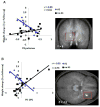Reward circuitry responsivity to food predicts future increases in body mass: moderating effects of DRD2 and DRD4
- PMID: 20116437
- PMCID: PMC3987805
- DOI: 10.1016/j.neuroimage.2010.01.081
Reward circuitry responsivity to food predicts future increases in body mass: moderating effects of DRD2 and DRD4
Abstract
Objective: To determine whether responsivity of reward circuitry to food predicts future increases in body mass and whether polymorphisms in DRD2 and DRD4 moderate these relations.
Design: The functional magnetic resonance imaging (fMRI) paradigm investigated blood oxygen level dependent activation in response to imagined intake of palatable foods, unpalatable foods, and glasses of water shown in pictures. DNA was extracted from saliva samples using standard salting-out and solvent precipitation methods.
Participants: Forty-four adolescent female high school students ranging from lean to obese.
Main outcome: Future increases in body mass index (BMI).
Results: Weaker activation of the frontal operculum, lateral orbitofrontal cortex, and striatum in response to imagined intake of palatable foods, versus imagined intake of unpalatable foods or water, predicted future increases in body mass for those with the DRD2 TaqIA A1 allele or the DRD4-7R allele. Data also suggest that for those lacking these alleles, greater responsivity of these food reward regions predicted future increases in body mass.
Discussion: This novel prospective fMRI study indicates that responsivity of reward circuitry to food increases risk for future weight gain, but that genes that impact dopamine signaling capacity moderate the predictive effects, suggesting two qualitatively distinct pathways to unhealthy weight gain based on genetic risk.
2010 Elsevier Inc. All rights reserved.
Figures




References
-
- Anchordoquy HC, McGeary C, Liu L, Krauter KS, Smolen A. Genotyping of three candidate genes following whole genome preamplification of DNA collected from buccal cells. Behav Genet. 2003;33(1):73–78. - PubMed
-
- Asghari V, Sanyal S, Buchwaldt S, Paterson A, Jovanovic V, Van Tol HH. Modulation of intracellular cyclic AMP levels by different human dopamine D4 receptor variants. J Neurochem. 1995;65(3):1157–1165. - PubMed
-
- Brody AL, Mandelkern MA, Olmstead RE, Scheibal D, Hahn E, Shiraga S, Zamora-Paja E, Farahi J, Saxena S, London ED, McCracken JT. Gene variants of brain dopamine pathways and smoking-induced dopamine release in the ventral caudate/nucleus accumbens. Arch Gen Psychiatry. 2006;63(7):808–816. - PMC - PubMed
-
- Bowirrat A, Oscar-Berman M. Relationship between dopaminergic neurotransmission, alcoholism, and Reward Deficiency syndrome. Am J Med Genet B. 2005;132B(1):29–37. - PubMed
Publication types
MeSH terms
Substances
Grants and funding
LinkOut - more resources
Full Text Sources
Medical

